Papers by Viktor Malanushenko

The Astrophysical Journal, May 24, 2012
We examine the α-element abundance ratio, [α/Fe], of 5620 stars, observed by the Sloan Extension ... more We examine the α-element abundance ratio, [α/Fe], of 5620 stars, observed by the Sloan Extension for Galactic Understanding and Exploration survey in the region 6 kpc < R < 16 kpc, 0.15 kpc < |Z| < 1.5 kpc, as a function of Galactocentric radius R and distance from the Galactic plane |Z|. Our results show that the high-α thick disk population has a short scale length (L thick ∼ 1.8 kpc) compared to the low-α population, which is typically associated with the thin disk. We find that the fraction of high-α stars in the inner disk increases at large |Z|, and that high-α stars lag in rotation compared to low-α stars. In contrast, the fraction of high-α stars in the outer disk is low at all |Z|, and high-and low-α stars have similar rotational velocities up to 1.5 kpc from the plane. We interpret these results to indicate that different processes were responsible for the high-α populations in the inner and outer disk. The high-α population in the inner disk has a short scale length and large scale
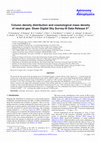
Astronomy and Astrophysics, Oct 22, 2012
We present the first results from an ongoing survey for damped Lyman-α systems (DLAs) in the spec... more We present the first results from an ongoing survey for damped Lyman-α systems (DLAs) in the spectra of z > 2 quasars observed in the course of the Baryon Oscillation Spectroscopic Survey (BOSS), which is part of the Sloan Digital Sky Survey (SDSS) III. Our full (non-statistical) sample, based on Data Release 9, comprises 12 081 systems with log N(H i) ≥ 20, out of which 6839 have log N(H i) ≥ 20.3. This is the largest DLA sample ever compiled, superseding that from SDSS-II by a factor of seven. Using a statistical sub-sample and estimating systematics from realistic mock data, we probe the N(H i) distribution at z = 2.5. Contrary to what is generally believed, the distribution extends beyond 10 22 cm −2 with a moderate slope of index ≈−3.5. This result matches the opacity-corrected distribution observed at z = 0 surprisingly well. The cosmological mass density of neutral gas in DLAs is found to be Ω DLA g ≈ 10 −3 , evolving only mildly over the past 12 billion years.

Astronomy and Astrophysics, Nov 18, 2015
The inner Galactic bulge has, until recently, been avoided in chemical evolution studies because ... more The inner Galactic bulge has, until recently, been avoided in chemical evolution studies because of extreme extinction and stellar crowding. Large, near-IR spectroscopic surveys, such as the Apache Point Observatory Galactic Evolution Experiment (APOGEE), for the first time allow the measurement of metallicities in the inner region of our Galaxy. We study metallicities of 33 K/M giants situated in the Galactic center region from observations obtained with the APOGEE survey. We selected K/M giants with reliable stellar parameters from the APOGEE/ASPCAP pipeline. Distances, interstellar extinction values, and radial velocities were checked to confirm that these stars are indeed situated in the inner Galactic bulge. We find a metal-rich population centered at [M/H] = +0.4 dex, in agreement with earlier studies of other bulge regions, but we also discovered a peak at low metallicity around [M/H] = −1.0 dex. This finding suggests the presence of a metal-poor population, which has not previously been detected in the central region. Our results indicate a dominant metal-rich population with a metal-poor component that is enhanced in the α-elements. This metal-poor population may be associated with the classical bulge and a fast formation scenario.

We present a measurement of the volumetric Type Ia supernova (SN Ia) rate based on data from the ... more We present a measurement of the volumetric Type Ia supernova (SN Ia) rate based on data from the Sloan Digital Sky Survey II (SDSS-II) Supernova Survey. The adopted sample of supernovae (SNe) includes 516 SNe Ia at redshift z 0.3, of which 270(52%) are spectroscopically identified as SNe Ia. The remaining 246 SNe Ia were identified through their light curves; 113 of these objects have spectroscopic redshifts from spectra of their host galaxy, and 133 have photometric redshifts estimated from the SN light curves. Based on consideration of 87 spectroscopically confirmed non-Ia SNe discovered by the SDSS-II SN Survey, we estimate that 2.04 +1.61 −0.95 % of the photometric SNe Ia may be misidentified. The sample of SNe Ia used in this measurement represents an order of magnitude increase in the statistics for SN Ia rate measurements in the redshift range covered by the SDSS-II Supernova Survey. If we assume an SN Ia rate that is constant at low redshift (z < 0.15), then the SN observations can be used to infer a value of the SN rate of r V = (2.69 +0.34+0.21 −0.30−0.01)×10 −5 SNe yr −1 Mpc −3 (H 0 /(70 km s −1 Mpc −1)) 3 at a mean redshift of ∼0.12, based on 79 SNe Ia of which 72 are spectroscopically confirmed. However, the large sample of SNe Ia included in this study allows us to place constraints on the redshift dependence of the SN Ia rate based on the SDSS-II Supernova Survey data alone. Fitting a power-law model of the SN rate evolution, r V (z) = A p × ((1 + z)/(1 + z 0)) ν , over the redshift range 0.0 < z < 0.3 with z 0 = 0.21, results in A p = (3.43 +0.15 −0.15) × 10 −5 SNe yr −1 Mpc −3 (H 0 /(70 km s −1 Mpc −1)) 3 and ν = 2.04 +0.90 −0.89 .
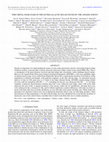
The astrophysical journal, Mar 26, 2013
Despite its importance for understanding the nature of early stellar generations and for constrai... more Despite its importance for understanding the nature of early stellar generations and for constraining Galactic bulge formation models, at present little is known about the metal-poor stellar content of the central Milky Way. This is a consequence of the great distances involved and intervening dust obscuration, which challenge optical studies. However, the Apache Point Observatory Galactic Evolution Experiment (APOGEE), a wide-area, multifiber, highresolution spectroscopic survey within Sloan Digital Sky Survey III, is exploring the chemistry of all Galactic stellar populations at infrared wavelengths, with particular emphasis on the disk and the bulge. An automated spectral analysis of data on 2403 giant stars in 12 fields in the bulge obtained during APOGEE commissioning yielded five stars with low metallicity ([Fe/H] −1.7), including two that are very metal-poor [Fe/H] ∼ −2.1 by bulge standards. Luminosity-based distance estimates place the 5 stars within the outer bulge, where 1246 of the other analyzed stars may reside. A manual reanalysis of the spectra verifies the low metallicities, and finds these stars to be enhanced in the α-elements O, Mg, and Si without significant α-pattern differences with other local halo or metal-weak thick-disk stars of similar metallicity, or even with other more metal-rich bulge stars. While neither the kinematics nor chemistry of these stars can yet definitively determine which, if any, are truly bulge members, rather than denizens of other populations co-located with the bulge, the newly identified stars reveal that the chemistry of metal-poor stars in the central Galaxy resembles that of metal-weak thick-disk stars at similar metallicity.
Central European Astrophysical Bulletin, 2013
ABSTRACT We present our CCD observations of a new WZ Sge-type dwarf nova in Draco (PNV J18422792+... more ABSTRACT We present our CCD observations of a new WZ Sge-type dwarf nova in Draco (PNV J18422792+4837425) during its superoutburst in 2011. At the plateau of the superoutburst of this unique object, superhumps with very small amplitude were detected. During a decline of brightness, the unusual long rebrightening followed by a short one were observed. The evolution of the multicolour light curves during all stages of the superoutburst is described. The superhumps periods were determined. We suggested the existence of the late superhumps at the final decline of the superoutburst, which lasted about 170 days.

Astrophysics, Mar 1, 2018
Results from observation campaigns for the dwarf nova NY Ser during 2014 and 2016 are presented. ... more Results from observation campaigns for the dwarf nova NY Ser during 2014 and 2016 are presented. Data were obtained on a total of 126 nights in 2014 that include 20 normal outbursts and one superoutburst and on 22 nights in 2016 that include 5 normal outbursts. The shape of the curves for the normal outbursts indicated the existence of "outside-in" and "inside-out" outbursts in this system. In different stages of outburst activity (quiescent state, outburst, and superoutburst) NY Ser manifests brightness oscillations with different periods. In the quiescent state and in normal outbursts, the orbital period 0 d .097558(6) predominated. During the superoutburst we identified two stages in the evolution of superhumps: a stage in which the tidal instability of the accretion disk increases (A) and a stage with developed superhumps (B). Stage A for NY Ser has been identified for the first time, but its duration and period are not uniquely determined. In stage B, positive superhumps with an average period of 0 d .10464(9) and a period excess of ε = 0.072 were recorded and negative superhumps with an average period of 0 d .0938(1) and a period deficit of ε =-0.038 were detected for the first time.
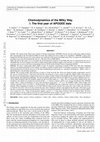
Context. The Apache Point Observatory Galactic Evolution Experiment (APOGEE) features the first m... more Context. The Apache Point Observatory Galactic Evolution Experiment (APOGEE) features the first multi-object high-resolution fiber spectrograph in the Near-infrared (NIR) ever built, thus making the survey unique in its capabilities: APOGEE is able to peer through the dust that obscures stars in the Galactic disc and bulge in the optical wavelength range. Here we explore the APOGEE data included as part of the Sloan Digital Sky Survey's 10th data release (SDSS DR10). Aims. The goal of this paper is to a) investigate the chemo-kinematic properties of the Milky Way disc by exploring the first year of APOGEE data, and b) to compare our results to smaller optical high-resolution samples in the literature, as well as results from lower resolution surveys such as the Geneva-Copenhagen Survey (GCS) and the RAdial Velocity Experiment (RAVE). Methods. We select a high-quality (HQ) sample in terms of chemistry (amounting to around 20.000 stars) and, after computing distances and orbital parameters for this sample, we employ a number of useful subsets to formulate constraints on Galactic chemical and chemodynamical evolution processes in the Solar neighbourhood and beyond (e.g., metallicity distributions-MDFs, [α/Fe] vs. [Fe/H] diagrams, and abundance gradients). Results. Our red giant sample spans distances as large as 10 kpc from the Sun. Given our chemical quality requirements, most of the stars are located between 1 and 6 kpc from the Sun, increasing by at least a factor of eight the studied volume with respect to the most recent chemodynamical studies based on the two largest samples obtained from RAVE and the Sloan Extension for Galactic Understanding and Exploration (SEGUE). We find remarkable agreement between the MDF of the recently published local (d < 100 pc) high-resolution high-S/N HARPS sample and our local HQ sample (d < 1 kpc). The local MDF peaks slightly below solar metallicity, and exhibits an extended tail towards [Fe/H] = −1, whereas a sharper cutoff is seen at larger metallicities (the APOGEE sample shows a slight overabundance of stars with metallicities larger than +0.3 w.r.t. the HARPS sample). Both samples also compare extremely well in an [α/Fe] vs. [Fe/H] diagram. The APOGEE data also confirm the existence of a gap in the abundance diagram. When expanding our sample to cover three different Galactocentric distance bins (inner disc, solar vicinity and outer disc), we find the high-[α/Fe] stars to be rare towards the outer zones (implying a shorter scale-length of the thick disc with respect to the thin disc) as previously suggested in the literature. Finally, we measure the gradients in [Fe/H] and [α/Fe], and their respective MDFs, over a range of 6 < R < 11 kpc in Galactocentric distance, and a 0 < z < 3 kpc range of distance from the Galactic plane. We find a good agreement with the gradients traced by the GCS and RAVE dwarf samples. For stars with 1.5 < z < 3 kpc (not present in the previous samples), we find a positive metallicity gradient and a negative gradient in [α/Fe].

Monthly Notices of the Royal Astronomical Society, Mar 17, 2015
MaNGA (Mapping Nearby Galaxies at Apache Point Observatory) is a 6-yr SDSS-IV (Sloan Digital Sky ... more MaNGA (Mapping Nearby Galaxies at Apache Point Observatory) is a 6-yr SDSS-IV (Sloan Digital Sky Survey IV) survey that will obtain resolved spectroscopy from 3600 to 10 300 Å for a representative sample of over 10 000 nearby galaxies. In this paper, we derive spatially resolved stellar population properties and radial gradients by performing full spectral fitting of observed galaxy spectra from P-MaNGA, a prototype of the MaNGA instrument. These data include spectra for 18 galaxies, covering a large range of morphological type. We derive age, metallicity, dust, and stellar mass maps, and their radial gradients, using high spectralresolution stellar population models, and assess the impact of varying the stellar library input to the models. We introduce a method to determine dust extinction which is able to give smooth stellar mass maps even in cases of high and spatially non-uniform dust attenuation. With the spectral fitting, we produce detailed maps of stellar population properties which allow us to identify galactic features among this diverse sample such as spiral structure, smooth radial profiles with little azimuthal structure in spheroidal galaxies, and spatially distinct galaxy sub-components. In agreement with the literature, we find the gradients for galaxies identified as early type to be on average flat in age, and negative (−0.15 dex/R e) in metallicity, whereas the gradients for late-type galaxies are on average negative in age (−0.39 dex/R e) and flat in metallicity. We demonstrate how different levels of data quality change the precision with which radial gradients can be measured. We show how this analysis, extended to the large numbers of MaNGA galaxies, will have the potential to shed light on galaxy structure and evolution.
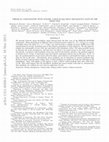
The Astronomical Journal, Apr 11, 2014
We present Galactic mean metallicity maps derived from the first year of the SDSS-III APOGEE expe... more We present Galactic mean metallicity maps derived from the first year of the SDSS-III APOGEE experiment. Mean abundances in different zones of Galactocentric radius (0 < R < 15 kpc) at a range of heights above the plane (0 < |z| < 3 kpc), are derived from a sample of nearly 20,000 stars with unprecedented coverage, including stars in the Galactic mid-plane at large distances. We also split the sample into subsamples of stars with low and high-[α/M] abundance ratios. We assess possible biases in deriving the mean abundances, and find they are likely to be small except in the inner regions of the Galaxy. A negative radial gradient exists over much of the Galaxy; however, the gradient appears to flatten for R < 6 kpc, in particular near the Galactic mid-plane and for low-[α/M] stars. At R > 6 kpc, the gradient flattens as one moves off of the plane, and is flatter at all heights for high-[α/M] stars than for low-[α/M] stars. Alternatively, these gradients can be described as vertical gradients that flatten at larger Galactocentric radius; these vertical gradients are similar for both low and high-[α/M] populations. Stars with higher [α/M] appear to have a flatter radial gradient than stars with lower [α/M]. This could suggest that the metallicity gradient has grown steeper with time or, alternatively, that gradients are washed out over time by migration of stars.
Publications of the Astronomical Institute of the Czechoslovak Academy of Sciences, 1987
ABSTRACT Radial velocities of Hγ - H9 and Ca II K lines on 27 high dispersion (0.27 nm/mm) spectr... more ABSTRACT Radial velocities of Hγ - H9 and Ca II K lines on 27 high dispersion (0.27 nm/mm) spectrograms of the HgMn-star Alpha Andromedae were measured. The first measurements indicate a possibility of two nonradial oscillations.
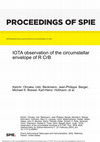
Astronomische Gesellschaft Abstract Series, 2002
We report the first long-baseline interferometric observations of R CrB. The observations were ca... more We report the first long-baseline interferometric observations of R CrB. The observations were carried out at the Infrared Optical Telescope Array (IOTA), using our new JHK beam combiner which enables us to record fringes simultaneously in the J-, Hand nd K-bands. The circumstellar envelope of R CrB is resolved at a baseline of 21 m, and the K-band visibility is derived to be 0.61 ± 0.03 along a position angle of ∼ 170 •. The visibility obtained with IOTA, as well as speckle visibilities with baselines up to 6 m and the spectral energy distribution (SED), are fitted with 2-component models consisting of the central star and an optically thin dust shell. The K-band visibilities predicted by the models are about 10% smaller than the visibility obtained with IOTA. However, given the simplifications adopted in our models and the complex nature of the object, this can be regarded as rough agreement. As a hypothesis to explain the small discrepancy, we propose that there might be a group of newly formed dust clouds, which might appear as a third visibility component.

ABSTRACT A long-term monitoring of the asynchronous polar BY Cam has been carried out by several ... more ABSTRACT A long-term monitoring of the asynchronous polar BY Cam has been carried out by several groups of observers in a total over the years 1988-2012. Apart from the 3.3-hr periodicity related to the orbital variation and ˜15 d periodicity caused by the the spin-orbital asynchronizm, BY Cam displays the brightness variation on the much longer time scale of hundreds and thousands of days. Basing on our 8-year interval of photometric observations from 2004 to 2012, we examined the existence of 100-150 d precession of the white dwarf spin axes suggested by Piirola et al. (1994) and ˜5 year quasi-period found by Honeycutt and Kafka (2005) in brightness variations. We did not find any convincing evidence of the ˜145 d period observed by Honeycutt and Kafka (2005). Instead we found the existence of ˜ the 4.1-year variations in the years 2004-2012 and present their sine-like profile. The possible connection of these variations with ˜5 year quasi-period as well as its interpretation is considered.

Monthly Notices of the Royal Astronomical Society, Aug 2, 2016
Using kinematic maps from the Sloan Digital Sky Survey (SDSS) Mapping Nearby Galaxies at Apache P... more Using kinematic maps from the Sloan Digital Sky Survey (SDSS) Mapping Nearby Galaxies at Apache Point Observatory (MaNGA) survey, we reveal that the majority of low-mass quenched galaxies exhibit coherent rotation in their stellar kinematics. Our sample includes all 39 quenched low-mass galaxies observed in the first year of MaNGA. The galaxies are selected with M r > −19.1, stellar masses 10 9 M < M * < 5 × 10 9 M , EW Hα < 2 Å, and all have red colours (u − r) > 1.9. They lie on the size-magnitude and σ-luminosity relations for previously studied dwarf galaxies. Just six (15 ± 5.7 per cent) are found to have rotation speeds v e, rot < 15 km s −1 at ∼1 R e , and may be dominated by pressure support at all radii. Two galaxies in our sample have kinematically distinct cores in their stellar component, likely the result of accretion. Six contain ionized gas despite not hosting ongoing star formation, and this gas is typically kinematically misaligned from their stellar component. This is the first large-scale Integral Field Unit (IFU) study of low-mass galaxies selected without bias against low-density environments. Nevertheless, we find the majority of these galaxies are within ∼1.5 Mpc of a bright neighbour (M K < −23; or M * > 5 × 10 10 M), supporting the hypothesis that galaxy-galaxy or galaxy-group interactions quench star formation in lowmass galaxies. The local bright galaxy density for our sample is ρ proj = 8.2 ± 2.0 Mpc −2 , compared to ρ proj = 2.1 ± 0.4 Mpc −2 for a star-forming comparison sample, confirming that the quenched low-mass galaxies are preferentially found in higher density environments.
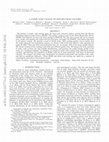
The Astrophysical Journal, Jan 25, 2017
We present a cosmic void catalog using the large-scale structure galaxy catalog from the Baryon O... more We present a cosmic void catalog using the large-scale structure galaxy catalog from the Baryon Oscillation Spectroscopic Survey (BOSS). This galaxy catalog is part of the Sloan Digital Sky Survey (SDSS) Data Release 12 and is the final catalog of SDSS-III. We take into account the survey boundaries, masks, and angular and radial selection functions, and apply the ZOBOV void finding algorithm to the galaxy catalog. We identify a total of 10,643 voids. After making quality cuts to ensure that the voids represent real underdense regions, we obtain 1,228 voids with effective radii spanning the range 20-100h −1 Mpc and with central densities that are, on average, 30% of the mean sample density. We release versions of the catalogs both with and without quality cuts. We discuss the basic statistics of voids, such as their size and redshift distributions, and measure the radial density profile of the voids via a stacking technique. In addition, we construct mock void catalogs from 1000 mock galaxy catalogs, and find that the properties of BOSS voids are in good agreement with those in the mock catalogs. We compare the stellar mass distribution of galaxies living inside and outside of the voids, and find no significant difference. These BOSS and mock void catalogs are useful for a number of cosmological and galaxy environment studies.

ABSTRACT Attempts to estimate the time of a spin-orbital synchronization for asynchronous polar B... more ABSTRACT Attempts to estimate the time of a spin-orbital synchronization for asynchronous polar BY Cam have been made many times since 1994 year. However the estimates obtained did not coincide in a wide region, varying from 150 years (Piirola et al. 1994) up to &gt;3500 years (Kafka et al. 2005). We have undertaken photometric observations of BY Cam over 8.1 years (2004 - 2012) and collected an array of data covering 998 hours during 178 nights. Analyzing the data, we have obtained the most reliable estimate of the spin-orbital time synchronization, Ts = 250±20 years, which agrees very well with both Ts = 150- 290 yrs for asynchronous polar V1500 Cyg (Pavlenko &amp; Pelt 1991); (Stockman et al. 1988) and the theoretically predicted Ts &lt; 1000 yr for asynchronous polars as a whole (Andronov 1987). We also found that the accretion stream switches between two dipole magnetic poles and the equatorial magnetic poles during a synodic ˜ 15-d cycle; the number of switching and their phases can be kept during neighbor cycles but varies on a scale of years. Probably this may depend on the phase of the long-term ˜ 1500 day periodicity (Andreev et al. 2012).
The astrophysical journal, Jul 31, 2012
The astrophysical journal, Jul 31, 2012











Uploads
Papers by Viktor Malanushenko